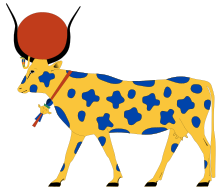Hesat
| Part of a series on |
| Ancient Egyptian religion |
|---|
 |
|
|

Hesat is an
In Egyptian mythology, Hathor is one of the main cattle deities as she is the mother of Horus and Ra and closely associated with the role of royalty and kingship.[2] Hesat is one of Hathor's manifestations, usually portrayed as a white cow representing purity and the milk that she produces to give life to humanity.[2] Other feminine bovine deities include Sekhat-Hor, Mehet-Weryt, and Shedyt.[3] Their masculine counterparts include Apis, Mnevis, Sema-wer, Ageb-wer.[3]
Artistic representations
While there are not many images of Hesat that are recorded and published, there are a few representations on pieces that belong to major museums worldwide. The Metropolitan Museum of Art has in its collection Scarab with the Representation of Hathor as a Cow.[4] The hieroglyphs on this late period piece read ḥȜst or ḥsȜt determined with a recumbent cow with the following hieroglyphs:
| |
This spelling of her name is using cryptographic substitution, which became established in the New Kingdom.[5] Traditionally phonetic spellings of Hesat's name from earlier periods were usually written as follows:[6]
| |
References
- ^ Wilkinson, Richard H. (2003). The Complete Gods and Goddesses of Ancient Egypt. Thames & Hudson. pp. 173–174
- ^ a b "Hathor". World History Encyclopedia. Retrieved 2018-12-03.
- ^ .
- ^ Metropolitan Museum of Art staff member. "Scarab with the Representation of Hathor as Cow". www.metmuseum.org. Retrieved 2018-12-03.
- ISBN 9781937040253.
- OCLC 4466599.
